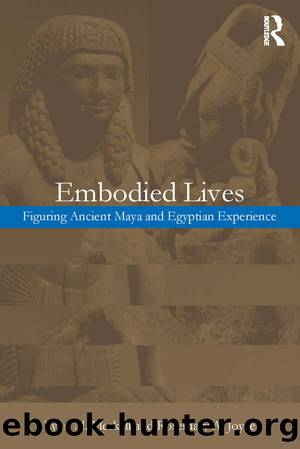Embodied Lives: by Meskell Lynn. Joyce Rosemary A

Author:Meskell, Lynn.,Joyce, Rosemary A.
Language: eng
Format: epub
ISBN: 9781317724544
Publisher: Taylor & Francis (CAM)
Fatal fluids
Bodily fluids retained the powerful essence of the gods, and even of pharaoh. Yet certain fluids were dangerous. Semen and blood were considered unclean and menstruating women were ritually impure. Menstrual blood might thus be used as a repellent. The tyet amulet, probably linked to menstruation, resembled a girdle or sanitary towel, and was made from red stone. Like saliva, urine was considered as both cleansing and destructive. Following Mary Douglas, some pollutants may be perceived as expressing general views of the social order. This suggests that sexual contact was dangerous, the threat expressed through contact with sexual fluids. It was men who were most at risk, reflecting the sexual asymmetry of Egyptian society. The urine of a pregnant woman was especially potent, with life-giving properties. An ancient Egyptian pregnancy test consisted of having the woman urinate on young plants:if they grew, she was pregnant; if they died, she was not. Mother's milk, either human or animal, was positively power-laden. It was regularly used in medical prescriptions. If a woman wished to know whether she could conceive she drank the milk of a woman who had borne a son: if she vomited she either was, or would soon be, pregnant (Pinch 1994:82). Fluids were powerful, almost independent entities that seeped from the innermost regions and secret parts of the body (Grosz 1995: 196).
Predominant magical ingredients consisted of menstrual blood, animal blood, and animal dung. Human detritus such as saliva, hair or nail clippings could also be used. Exuviae can be considered the products of the abject body that exist in a borderline state, signaling danger and vulnerability (Grosz 1994:187â210). According to Gell (1998:104), exuviae sorcery worked âbecause of the intimate causal nexus between exuviae and the person responsible for them. These exuviae do not stand metonymically for the victim; they are physically detached fragments of the victim's âdistributed personhoodâ ⦠beyond the body-boundary.â Egyptian pharmacopoeia illustrates an extensive use of blood and excrement:there are nineteen words for different types of excrement cited in the papyri. A substantial portion of the Coffin Texts feature the deceased's denials of drinking urine or eating excrement, usually seen as a metaphor for chaos or the world turned upside down. Following Mary Douglas, Kadish (1979) argues for an extended meaning:it is an explicit statement by each individual about choosing to be part of the moral order of the universe. The deceased states (Kadish 1979): What I doubly detest, I do not eat. What I detest is excrement; I do not eat it. Faeces, it does not enter this mouth of mine.
These imaginings and phantasies must have haunted the Egyptians, since they figure so prominently in the fabrications of the afterlife and its trials, but also in that other fundamental liminal space, the dreamworld. Some literate Egyptian men possessed what scholars have termed Dream Books, which followed a formulaic structure and sought to provide meaningful interpretations and portents based on the composition of dreams. One such book belonged to a man called Qenhirkhopshef, a scribe at Deir el Medina, who handed the book on to his descendants (Gardiner 1935:12).
Download
This site does not store any files on its server. We only index and link to content provided by other sites. Please contact the content providers to delete copyright contents if any and email us, we'll remove relevant links or contents immediately.
They Both Die at the End by Adam Silvera(9723)
Thirteen Reasons Why by Jay Asher(8800)
The Space Between by Michelle L. Teichman(6862)
Suicide Notes by Michael Thomas Ford(4764)
Tuesdays with Morrie by Mitch Albom(4695)
Suicide: A Study in Sociology by Emile Durkheim(2975)
The Checklist Manifesto by Atul Gawande(2779)
Tuesdays With Morrie by Mitch Albom(2697)
In the Woods by Tana French(2533)
Bossypants by Tina Fey(2468)
Robin by Dave Itzkoff(2386)
Olive Kitteridge by Elizabeth Strout(2312)
No Ashes in the Fire by Darnell L Moore(2297)
Reservoir 13 by Jon McGregor(2242)
End of Days by Sylvia Browne(2118)
All Things New by John Eldredge(2105)
Bus on Jaffa Road by Mike Kelly(2104)
Scar Tissue by Anthony Kiedis(2090)
No Time to Say Goodbye(2062)
